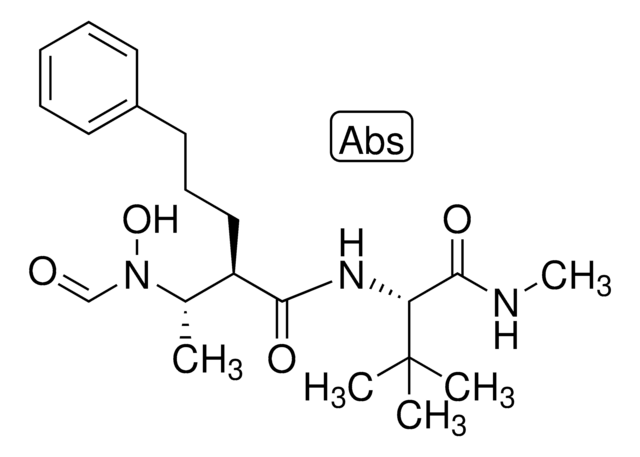565788
β-Secretase Inhibitor IV
≥98% (HPLC), solid, β-secretase inhibitor, Calbiochem®
Sinônimo(s):
β-Secretase Inhibitor IV, BACE Inhibitor C3
About This Item
Produtos recomendados
Nome do produto
β-Secretase Inhibitor IV, β-Secretase Inhibitor IV, CAS 797035-11-1, is a cell-permeable inhibitor that binds to BACE-1 active site and blocks its proteolytic activity (IC₅₀ = 15 nM for human BACE-1).
Nível de qualidade
Ensaio
≥98% (HPLC)
Formulário
solid
fabricante/nome comercial
Calbiochem®
condição de armazenamento
OK to freeze
protect from light
cor
white
solubilidade
DMSO: 100 mg/mL
Condições de expedição
ambient
temperatura de armazenamento
2-8°C
cadeia de caracteres SMILES
[S](=O)(=O)(N(C)c1cc(cc(c1)C(=O)N[C@H](C)c4ccccc4)C(=O)N[C@H]([C@H](O)CNC3CC3)Cc2ccccc2)C
InChI
1S/C31H38N4O5S/c1-21(23-12-8-5-9-13-23)33-30(37)24-17-25(19-27(18-24)35(2)41(3,39)40)31(38)34-28(16-22-10-6-4-7-11-22)29(36)20-32-26-14-15-26/h4-13,17-19,21,26,28-29,32,36H,14-16,20H2,1-3H3,(H,33,37)(H,34,38)/t21-,28+,29-/m1/s1
chave InChI
VPNIQGRFZCTBEZ-SPTGULJVSA-N
Descrição geral
Ações bioquímicas/fisiológicas
BACE-1 human
Embalagem
Advertência
Reconstituição
Outras notas
Stachel, S.J., et al. 2004. J. Med. Chem.47, 6447.
Informações legais
Código de classe de armazenamento
11 - Combustible Solids
Classe de risco de água (WGK)
WGK 1
Ponto de fulgor (°F)
Not applicable
Ponto de fulgor (°C)
Not applicable
Certificados de análise (COA)
Busque Certificados de análise (COA) digitando o Número do Lote do produto. Os números de lote e remessa podem ser encontrados no rótulo de um produto após a palavra “Lot” ou “Batch”.
Já possui este produto?
Encontre a documentação dos produtos que você adquiriu recentemente na biblioteca de documentos.
Nossa equipe de cientistas tem experiência em todas as áreas de pesquisa, incluindo Life Sciences, ciência de materiais, síntese química, cromatografia, química analítica e muitas outras.
Entre em contato com a assistência técnica





![MCA-[Asn670, Leu671]-Amyloid β/A4 Precursor Protein 770 Fragment 667-676-DNP-Lys-Arg-Arg-NH2 ≥90% (HPLC)](/deepweb/assets/sigmaaldrich/product/images/375/511/f63f11a7-86de-45c4-95a0-7afa616bb265/640/f63f11a7-86de-45c4-95a0-7afa616bb265.jpg)


